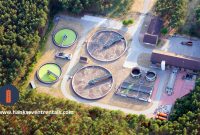Wastewater treatment plants play a crucial role in protecting our environment by treating sewage and industrial wastewater before it is released back into nature. These facilities ensure that harmful substances are removed or reduced to safe levels, making the water suitable for discharge or reuse. But how exactly does a wastewater treatment plant work? This article will walk you through each step of the process, providing a clear understanding of how wastewater is treated.
1. What is Wastewater?
Wastewater is any water that has been affected by human use, whether from households, industries, or commercial activities. It includes sewage, which comes from toilets, sinks, and drains, as well as industrial waste from factories. The composition of wastewater can vary greatly depending on its source, but it typically contains organic matter, chemicals, bacteria, and other pollutants that need to be treated before the water can be safely released into the environment.
2. The Importance of Wastewater Treatment
Untreated wastewater can cause severe environmental and health problems. When discharged directly into rivers, lakes, or oceans, it can pollute water bodies, harm aquatic life, and spread diseases. Proper treatment of wastewater removes or reduces contaminants, making the water safe for discharge or reuse in agriculture, industry, or even as drinking water in some cases. Wastewater treatment plants are essential for protecting public health and maintaining clean water resources.
3. The Wastewater Treatment Process: An Overview
Wastewater treatment involves several stages, each designed to remove specific types of contaminants. The main steps in a wastewater treatment plant include:
- Preliminary Treatment
- Primary Treatment
- Secondary Treatment
- Tertiary (or Advanced) Treatment
- Sludge Treatment and Disposal
Each of these stages plays a vital role in the overall process, ensuring that wastewater is treated effectively before it is released back into the environment.
4. Preliminary Treatment: The First Line of Defense
The preliminary treatment stage focuses on removing large debris and materials that could damage equipment or interfere with subsequent treatment processes. This stage typically involves the following steps:
- Screening: Large objects like sticks, plastics, and rags are removed using screens. These materials are then disposed of in landfills.
- Grit Removal: Sand, gravel, and other heavy particles are settled out in grit chambers. This prevents them from causing wear and tear on pumps and other machinery.
- Flow Equalization: Wastewater flow can vary significantly throughout the day. Flow equalization tanks help to balance these fluctuations, ensuring a steady flow through the treatment plant.
5. Primary Treatment: Settling Out the Solids
Primary treatment is designed to remove suspended solids and organic matter from the wastewater. This stage involves:
- Sedimentation: The wastewater is allowed to sit in large sedimentation tanks, where solids settle to the bottom, forming sludge. The sludge is then removed and sent for further treatment.
- Skimming: Grease, oil, and other floatable materials are skimmed off the surface of the water. This reduces the organic load on the next stages of treatment.
Primary treatment can remove up to 60% of suspended solids and 30-40% of organic matter from the wastewater, significantly reducing the burden on secondary treatment processes.
6. Secondary Treatment: Biological Processes at Work
Secondary treatment is where the majority of the organic matter and suspended solids are removed from the wastewater. This stage relies on biological processes to break down organic pollutants:
- Activated Sludge Process: In this process, microorganisms (bacteria) are added to the wastewater in aeration tanks. These bacteria consume the organic matter, breaking it down into simpler substances. Oxygen is pumped into the tanks to support the growth of aerobic bacteria, which are more efficient at treating the water.
- Trickling Filters: Wastewater is distributed over a bed of coarse materials, such as stones or plastic media, covered with a microbial biofilm. As the water trickles through the filter, the microorganisms in the biofilm break down organic pollutants.
- Lagoons or Stabilization Ponds: In some treatment plants, large, shallow ponds are used to treat wastewater. These ponds rely on natural processes, such as sunlight, algae growth, and bacterial activity, to break down pollutants.
After secondary treatment, the wastewater is significantly cleaner, with most of the organic matter and suspended solids removed. However, additional treatment may be necessary to remove other contaminants.
7. Tertiary (or Advanced) Treatment: Polishing the Water
Tertiary treatment is an advanced stage of wastewater treatment designed to remove any remaining contaminants, such as nutrients, heavy metals, or pathogens. This stage often includes:
- Filtration: Sand filters or membrane filters are used to remove fine particles that were not captured in earlier stages.
- Disinfection: The treated wastewater is disinfected to kill any remaining pathogens. Common methods include chlorination, UV radiation, or ozonation.
- Nutrient Removal: Excess nutrients like nitrogen and phosphorus, which can cause harmful algal blooms in water bodies, are removed through chemical precipitation or biological processes.
Tertiary treatment produces high-quality effluent that can be safely discharged into sensitive environments or reused for various purposes.
8. Sludge Treatment and Disposal: Managing the Byproduct
The sludge generated during primary and secondary treatment contains organic matter, nutrients, and pathogens, so it must be treated before disposal. Sludge treatment typically involves:
- Thickening: The sludge is concentrated to reduce its volume.
- Stabilization: The sludge is treated to reduce odors and pathogens. This can be done through anaerobic digestion, composting, or chemical stabilization.
- Dewatering: The stabilized sludge is further dewatered to reduce its volume and weight, making it easier to transport and dispose of.
- Disposal or Reuse: The treated sludge, known as biosolids, can be disposed of in landfills, incinerated, or reused as fertilizer in agriculture or land reclamation projects.
9. The Role of Automation and Technology in Wastewater Treatment
Modern wastewater treatment plants rely heavily on automation and advanced technologies to ensure efficient and effective treatment. Some of the key technologies used include:
- Supervisory Control and Data Acquisition (SCADA) Systems: SCADA systems monitor and control the treatment processes, allowing operators to respond quickly to any issues.
- Real-Time Sensors and Monitoring: Sensors are used to continuously monitor water quality parameters, such as pH, dissolved oxygen, and turbidity, ensuring that the treatment processes are functioning optimally.
- Advanced Oxidation Processes (AOPs): These chemical processes, such as ozone or UV-based treatments, are used to break down complex organic pollutants that are difficult to remove through conventional methods.
The integration of technology in wastewater treatment plants has improved efficiency, reduced operational costs, and enhanced the quality of treated water.
10. Challenges and Future Trends in Wastewater Treatment
While wastewater treatment has come a long way, there are still challenges to be addressed. Some of the key challenges include:
- Energy Consumption: Wastewater treatment is energy-intensive, particularly in the secondary and tertiary stages. Developing more energy-efficient processes is a priority.
- Emerging Contaminants: Pharmaceuticals, microplastics, and other emerging pollutants pose new challenges for treatment plants. Research is ongoing to find effective methods for removing these contaminants.
- Climate Change: Changing weather patterns and rising sea levels can impact wastewater treatment plants, particularly those in coastal areas. Adaptation strategies are needed to ensure resilience.
Future trends in wastewater treatment include the development of resource recovery technologies, such as energy generation from sludge or the extraction of valuable nutrients from wastewater. The focus is also shifting towards sustainable treatment methods that minimize environmental impact.
11. The Environmental and Economic Benefits of Wastewater Treatment
Investing in wastewater treatment has significant environmental and economic benefits. Properly treated wastewater protects ecosystems, improves public health, and ensures a sustainable supply of clean water. Moreover, by recovering resources from wastewater, such as energy and nutrients, treatment plants can reduce operational costs and contribute to a circular economy.
Wastewater treatment plants are essential for maintaining a clean and healthy environment. From the initial screening of large debris to the advanced treatment of emerging contaminants, each stage of the process plays a vital role in ensuring that wastewater is safely treated before being released back into nature. As technology and research continue to advance, the efficiency and effectiveness of wastewater treatment will only improve, helping to meet the challenges of the future.



